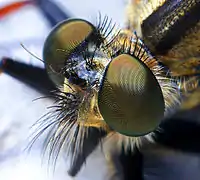Asiloidea
The Asiloidea comprise a very large superfamily insects in the order Diptera, the true flies. It has a cosmopolitan distribution, occurring worldwide, with many species living in dry, sandy habitat types. It includes the family Bombyliidae, the bee flies, which are parasitoids, and the Asilidae, the robber flies, which are predators of other insects. Members of the other families are mainly flower visitors as adults and predators as larvae.[1]
| Asiloidea | |
|---|---|
 | |
| Robber fly (Asilidae) with beetle prey | |
| Scientific classification | |
| Kingdom: | Animalia |
| Phylum: | Arthropoda |
| Class: | Insecta |
| Order: | Diptera |
| Infraorder: | Asilomorpha |
| Superfamily: | Asiloidea |
| Families | |
|
10 | |
It is not entirely clear that this superfamily is monophyletic. It is closely related to the Empidoidea and the Cyclorrhapha.[1][2]

Families
- Apioceridae – flower-loving flies
- Apsilocephalidae
- Apystomyiidae
- Asilidae – robber flies
- Bombyliidae – bee flies
- Evocoidae
- Hilarimorphidae
- Mydidae – mydas flies
- Mythicomyiidae
- Scenopinidae – window flies
- Therevidae – stiletto flies
The Protapioceridae, a family of extinct flies that were native to China, are also classified in the Asiloidea.[3]
References
- El-Hawagry, M. S. A. (2011). "Catalogue of Superfamily Asiloidea (Diptera: Brachycera) of Egypt" (PDF). Efflatounia. 11: 1–190. Archived from the original (PDF) on 2016-03-04. Retrieved 2013-10-10.
- Trautwein, M. D.; et al. (2010). "A multigene phylogeny of the fly superfamily Asiloidea (Insecta): Taxon sampling and additional genes reveal the sister-group to all higher flies (Cyclorrhapha)". Molecular Phylogenetics and Evolution. 56 (3): 918–30. doi:10.1016/j.ympev.2010.04.017. PMID 20399874.
- Zhang, K.; et al. (2007). "Notes on the extinct family Protapioceridae, with description of a new species from China (Insecta: Diptera: Asiloidea)" (PDF). Zootaxa. 1530: 27–32.
![]() Media related to Asiloidea at Wikimedia Commons
Media related to Asiloidea at Wikimedia Commons
![]() Data related to Asiloidea at Wikispecies
Data related to Asiloidea at Wikispecies